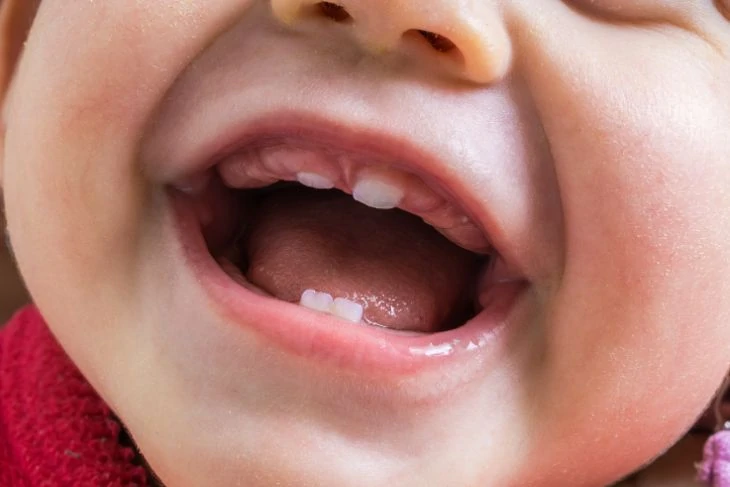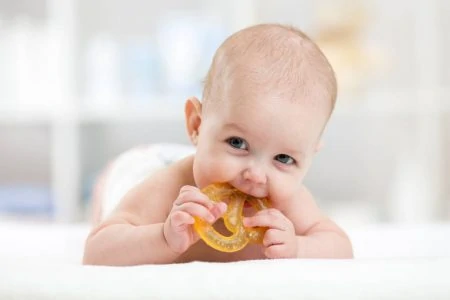Does it look like your baby will be cutting their first tooth soon?
Nothing can fill a mom with so much sadness and happiness simultaneously as seeing their baby reach that milestone of getting their first tooth. It makes you excited to reach the next stage of their development, but it also breaks your heart knowing you won’t see that toothless grin ever again.
This guide will cover when your baby’s teeth should come in, how to take care of them, and tips to soothe their aching gums.

Signs of Teething
Unless your baby is the exception to the rule, you’ll generally know when they start teething. A few babies seem to sail right through it, while others become fussy, agitated, and spend more time crying than usual.
When Does Teething Begin?
If your child gets its first tooth at four months, it’s entirely possible for teething to begin as soon as two months of age. Although that seems too soon, you have to keep in mind teething can happen two to three months before you see that tooth pop through (1).
Early teething is no cause for alarm — it just means your child might be reaching that milestone before another child typically does. It’s nothing to worry about so don’t psych yourself out if another parent mentions how early your baby is teething.
What Do Teething Gums Look Like?
A baby’s gums look similar to how they would before teething begins. If you pay close attention though, you’ll see they are a little different.
The gums may look a little swollen and a bit red right where the new tooth may be coming through.
What Are The Common Teething Symptoms?
Although symptoms can vary from child to child, they all share a few common ones. Here are some normal signs of teething that afflict many children (2):
- Drooling: If your baby starts drooling large amounts, you can safely suspect teething. If you’re noticing a lot of soaking wet bibs and shirts on your baby, teething is probably the culprit.
- Coughing: That thick drool can be overwhelming for your baby. If you notice them gagging or coughing sometimes and there’s no other reason for it, like a viral illness, teething could be to blame.
- A rash: All that drool can cause a red rash on your baby’s cheeks, chins, neck, and even chest from the wet clothes rubbing against its precious skin.
- Biting: A teething baby will bite on almost anything — everything is fair game. That includes their hands, your hands, teething toys, and even their own crib rails. If you’re breastfeeding, you might find them trying to go after your nipples as well.
- Fussiness: If you notice your normally happy baby has started acting irritable, teething might be the reason. It could last for hours, days, or even weeks.
- Crying: The crying can be hard for a parent because no one wants to see their baby in pain. But you can take some comfort in the fact the first couple of teeth seem to bother babies the most.
- Refusing food: When their mouths are sore, babies might refuse the bottle or breast. Just stay patient and keep attempting to get them to drink something or eat solid food.
- Frequent waking: Even good sleepers might wake up throughout the night during the worst part of their teething.
- Pulling on the ear: There are two main reasons babies sometimes do this — teething pain and ear infections. You’ll want to make sure to pay close attention to any other symptoms that would point toward an ear infection, such as fever.
What Are NOT Symptoms of Teething?
There are other symptoms some parents chalk up to teething, but experts say they’re likely caused by something else. These symptoms include:
- Diarrhea: Diarrhea isn’t normally caused by teething, according to the experts. It’s likelier your child ate something that didn’t agree with them or they’ve been exposed to a virus or bacteria.
- Fever: Some parents say low-grade fevers are a symptom of teething, but experts say it’s not a typical symptom.
- Runny nose: Babies can often get runny noses that seem to last for days, but teething isn’t the reason for those runny noses. A virus or allergies is the most likely reason for it.
- Lethargy: Your baby might be tired and a bit out of it when teething, but they shouldn’t be lethargic. If you notice your baby acting like that, look for other symptoms and call your doctor.
Do Baby Teeth Need to be Brushed?
Baby teeth need to be taken care of just as permanent teeth do. That means doing basic things to ensure they stay healthy. That includes:
- Wiping or brushing them regularly using a bit of fluoride toothpaste the size of a grain of rice.
- Avoiding sugary drinks for your kids.
- Setting up a dental appointment for your child when their first tooth appears or they have their first birthday.
Remedies for Teething
When you see your baby in pain, it’s only natural you want to help. Luckily there are quite a few things you can do to bring them some relief. Here are 20 solutions to try.
Teething Remedies to Avoid
Not all teething remedies are safe for your baby to try. Here are some you’ll want to avoid.
Avoid Baltic Amber Necklaces
Despite their recent popularity, experts warn against using Baltic amber necklaces because of the choking hazard they pose for babies.
In theory, these necklaces are supposed to work because they allegedly release a substance that relieves pain when the amber is warmed up by a baby’s mouth. The only problem is that science doesn’t show any evidence these necklaces work.
Avoid Numbing Gel
This makes both lists — things you can try and things you should avoid. Natural teething gels may be worth a try, which is why they made the list above. But any teething gel that contains benzocaine isn’t a good thing to give babies.
Benzocaine gels have been linked to a potentially fatal condition called methemoglobinemia.
Why It’s Bad
I always think of numbing gels as a last resort for teething pain. Acetaminophen seems to be safer and does a better job of helping take the edge off of the pain.
Avoid Essential Oils
Even though essential oils may have some benefit in other ways, putting them in your baby’s mouth is not safe (4). You should never rub any essential oil on your baby’s gums. They may get sick if you do so.
Essential oils can be toxic when applied to the skin undiluted and when they are ingested, both by adults and children. Essential oils shouldn’t be used at all-around a baby.
Avoid Whiskey
While this may seem like a no-brainer, moms in the past have used whiskey to relieve their baby’s teething pain. If you have a well-meaning grandma thrown into the mix, she might suggest trying this.
But you should tell her you’re not going to because it doesn’t work and that alcohol, even in small amounts, is bad for children.
Avoid Belladonna
Belladonna has been found in teething tablets and has been linked to adverse reactions such as seizures and even deaths. For that reason, you shouldn’t buy any teething product that contains belladonna.
Belladonna comes from the nightshade plant, which has earned a reputation for being deadly. If you’re still tempted to use it, keep in mind some of the potential side effects of belladonna are terrible, including hallucinations, blurred vision, fast heartbeat, convulsions, coma, and death.
How Teething Affects Breastfeeding
Breastfeeding is a great way to provide your baby with all the nutrition they need, but teething can complicate it. Here are some of the problems you and your baby may run into while you’re breastfeeding.
Your Baby May Want to Use Your Nipple as a Teether
This is one situation greatly feared by breastfeeding moms. We’re cool with using our breasts to provide nutrition to our babies, but the thought of all the nipple pain as your baby bites down on them is almost more than we can take.
But there are some moves you can pull to help cut down on the biting.
- Give your baby a teether before they start nursing.
- Use a clean finger to massage their gums before they feed.
- If your nipples have had all they can take, place the breast milk in a sippy cup or bottle and let them take it that way.
Your Baby May Want to Nurse More
If your baby seems to take comfort in nursing more when they’re teething, that’s great news. But your baby’s relief may come at a price you’ll have to pay. All that extra feeding could cause you to have sore or cracked nipples.
The best way to manage this is to go back to the basics of latching. Wait for a wide open mouth from baby, and be sure the latch is deep. Keep baby close to your body so that the nipple doesn’t get shallow in their mouth.
Editor's Note:
Michelle Roth, BA, IBCLCIf you’re having trouble with sore nipples because your baby is feeding more, dab fresh breast milk on your nipples at the end of a feeding. That can help soothe sore nipples.
You can also apply nipple cream. Just be sure to choose one that doesn’t need to be washed off before the next feeding since that may cause more pain.
And when you go to dry your nipples after washing them, pat them dry — don’t rub. Rubbing will just make the irritation worse.
Your Baby May Refuse Your Breast
While some babies want to feed constantly while breastfeeding, other babies hate to feed because the sucking motion makes the pressure in their gums feel worse. So how can a mom get her baby to take in breast milk while they are refusing the breast?
Before attempting a breastfeeding session, make sure your baby’s gums are well chilled by using the cold washcloth trick or letting them chew on a chilled teether. The ice rub may make your baby forget about the pain long enough to get a few ounces of breast milk in their belly.
Worst Case Scenario































